Key takeaways
– OptaPro’s advanced batting metrics can be applied to group batsmen with similar batting archetypes to inform key decisions relating to draft picks.
– Openers, middle order and lower order batsmen are split into different categories based on their scoring rate progression.
– By comparing ‘predicted runs per delivery’ outputs, teams can identify emerging and domestic players possessing similar outputs to high-profile performers.
– Amongst lower order batsmen, Andre Russell and Fabian Allen stand out as players who score quickly initially and then accelerate at a high rate.
After years of debate and speculation, franchise cricket as finally arrived in England with the launch of the ECB’s new Hundred competition.
The introduction of any new competition brings with it a number of challenges for the participating teams, not least building an identity which all players and staff can buy into.
However by the same token, it also offers each side’s senior management, coaches and analysts a rare opportunity to build a squad from scratch – identifying and recruiting elite players possessing the skills required to execute key strategies in line with their chosen brand of cricket.
Earlier this month each Hundred team picked their first three players – one centrally contracted red-ball England player and two ‘local-icon’ players. Eleven of the remaining twelve places, including three allocated for overseas players, will be determined by the inaugural Hundred draft, which is taking place on 20th October (the final ‘wildcard’ spot will be allocated next summer).
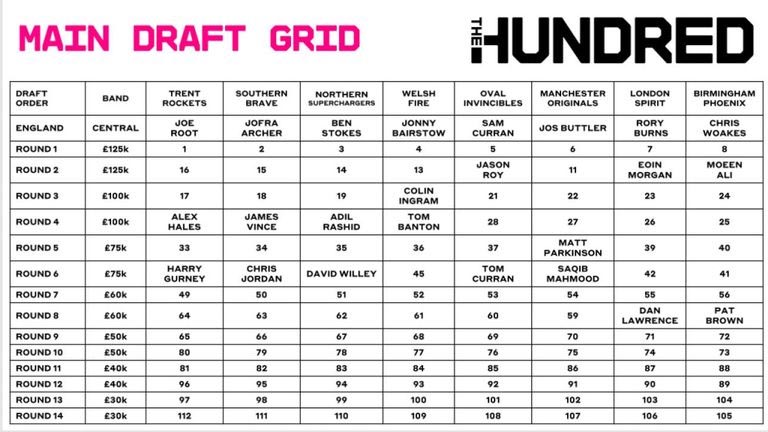
Each team will be able to choose from a long list of 570 players, including 240 from overseas, filling each slot with players meeting their key recruitment criteria.
This means the profiling and grouping of recruitment targets will be absolutely essential to inform draft strategy and earlier this year, OptaPro introduced new advanced batting metrics which can be applied to group together different batsmen with similar batting archetypes. More details on these metrics are available here.
Ahead of the draft we apply one of these metrics, ‘predicted runs per delivery’, to group T20 batsmen based on their domestic performances during last two years, which from a recruitment perspective could add an additional layer of context to inform a team’s selections.
Creating shortlists and covering all bases
It is highly likely that each team will have already determined their shortlist of preferred players, however the nature of the draft means that they are unlikely to be able to successfully recruit all their first-choices.
The added pressure of having 100 seconds to make a selection and the possibility of preferred players dropping out after failing to meet their reserve adds to potential complications to decision-making. Therefore having an informed understanding of player performance, particularly for emerging overseas batsmen profiling similarly to more established white-ball players, could be invaluable.
Looking beyond traditional outputs
The table below lists the leading run scorers across major T20 domestic competitions played in India, Australia, England, New Zealand, Pakistan, Bangladesh and the West Indies during the last two years.
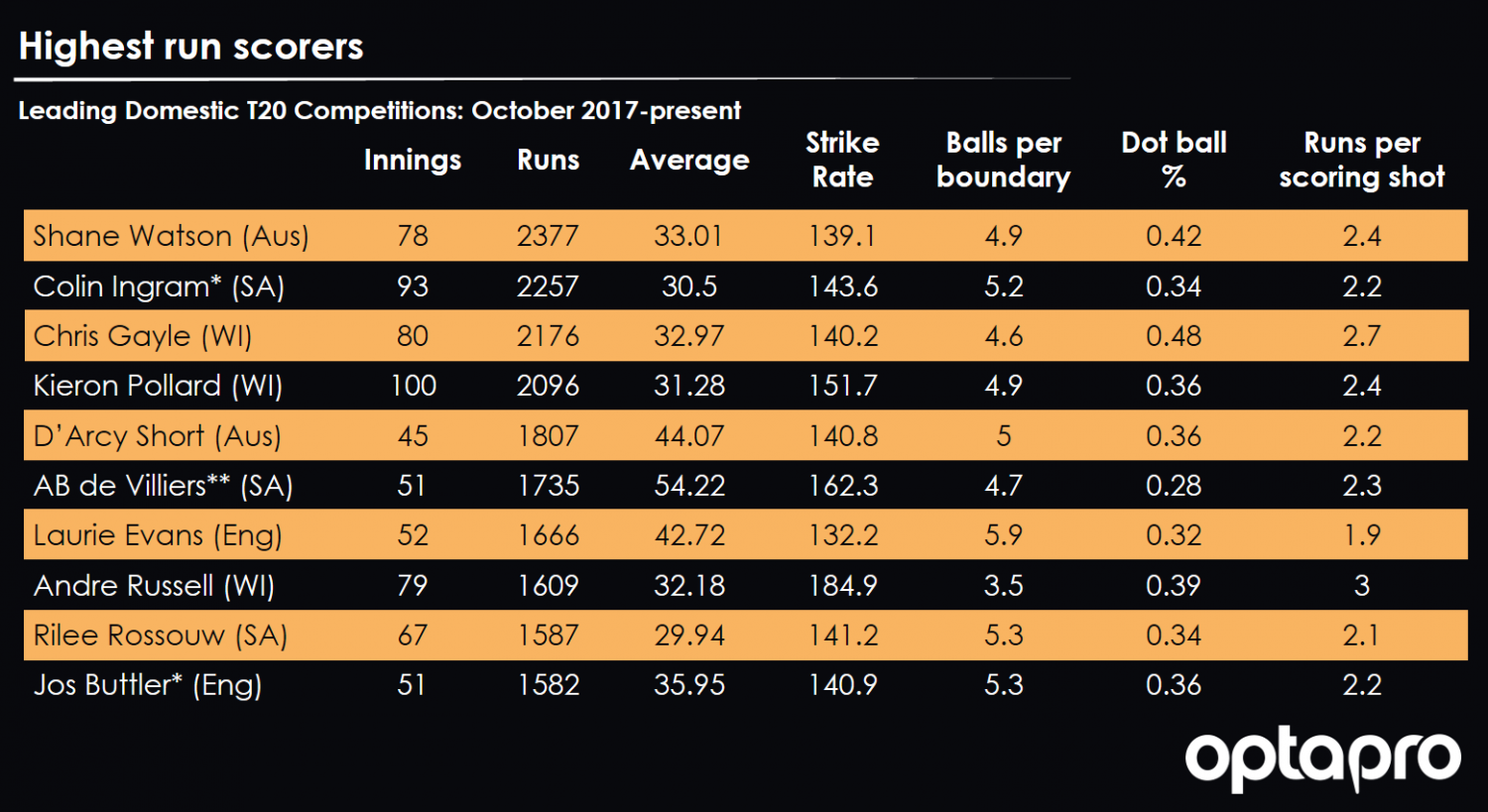
This list comprises players who adopt varying roles for their teams, with strike rates ranging from 132.2 (Laurie Evans) through to 184.9 (Andre Russell).
So to identify different types of player, we have taken every batter who has scored a minimum of 400 runs batting in the top five, or 200 runs batting at six or seven, in domestic T20 competitions since October 2017 and split them into categories based on their projected runs per delivery output.
The outputs for top five players are based on the first 40 deliveries they face, and 25 deliveries for those coming in at six or seven.
Profiling openers
The role of the opener can vary significantly based on the philosophy of the team and to reflect that, we have split openers into eight different groups based on how aggressive they are at the start of their innings and how their approach evolves once set.
Possessing an average of 47 and a strike-rate of 173 when opening, Moeen Ali sits alone in the most aggressive category, scoring and accelerating at a higher rate compared to an average T20 opener.
Moeen has already been picked during the first stage by Birmingham Phoenix, so won’t be part of the draft.
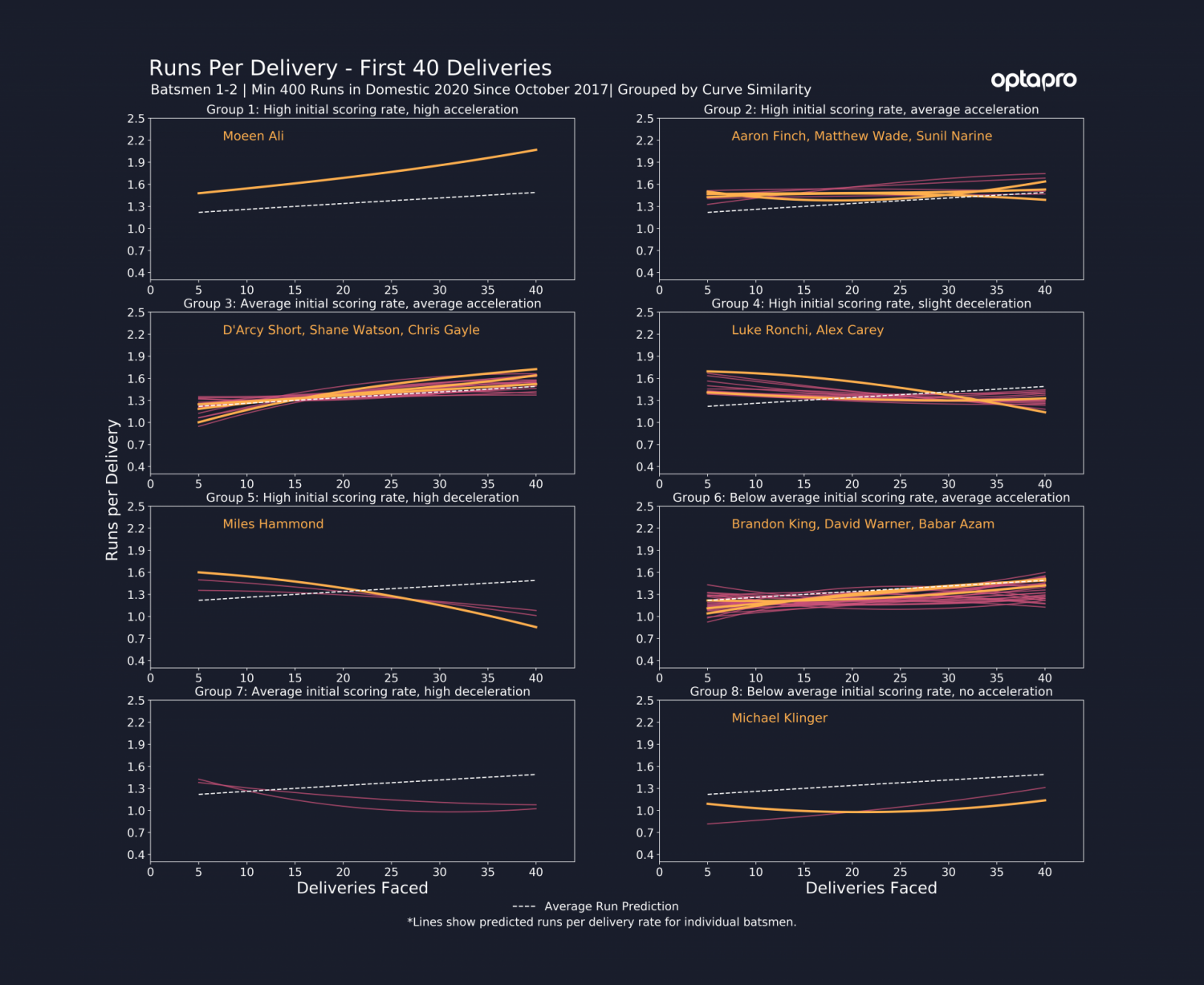
In the second group, featuring players who score quickly initially but then accelerate in line with the average, includes Aaron Finch and Matthew Wade together with Sunil Narine, known for his pinch-hitting role for KKR in the IPL. Finch and Narine enter the draft with a reserve of £100,000, with Wade’s reserve set at £60,000.
Profiled domestic players who also feature in this group include Phil Salt and Tom Banton, but the latter is another who has already been selected during the first stage.
The most common group is six, which features players who are not as aggressive early in their innings but once set, accelerate in line with what the model would expect an average opener to do. This group includes high-volume run scorers who bat deep into an innings, including Virat Kohli, who along with other Indian players won’t be appearing in the Hundred, in addition to the leading run scorers in this year’s IPL, CPL and Vitality Blast: David Warner, Brandon King and Babar Azam respectively. King is another notable absentee from the draft list.
Interestingly, the three openers who appear in the top-10 run scorers, Shane Watson, Chris Gayle and D’Arcy Short, all appear in the same category. Their performances fall in line with the average opener and of the three, Short has the lowest reserve, set at £50,000.
Distinguishing roles in the middle order
A franchise’s playing squad needs to comprise middle order players who can adapt to different match situations and conditions, whether it be capitalising on the powerplay, consolidating an innings or counterattacking.
Using predicted runs per delivery, we have been able to split players into different categories based on how they perform in the middle order, identifying emerging and domestic players possessing similar outputs to high-profile performers.
One good example is wicketkeeper-batsman Nicholas Pooran, who profiles very similarly to AB de Villiers in relation to accelerating quickly once set.
Kane Williamson is an example of a player who starts an innings slowly before steadily increasing his runs output after facing around 10 deliveries. Players in the draft who also feature in this category are Shimron Hetmyer and Laurie Evans. Evans has played in four different T20 competitions in 2019 and as an unreserved player, could be coveted by a number of teams looking for a batsman who can anchor an innings.
Steven Smith appears in another group who also start their innings slowly, but do not accelerate as quickly as the group featuring Williamson. Following a strong 2019 Blast campaign, England Lions batsman Sam Hain also features in this category.
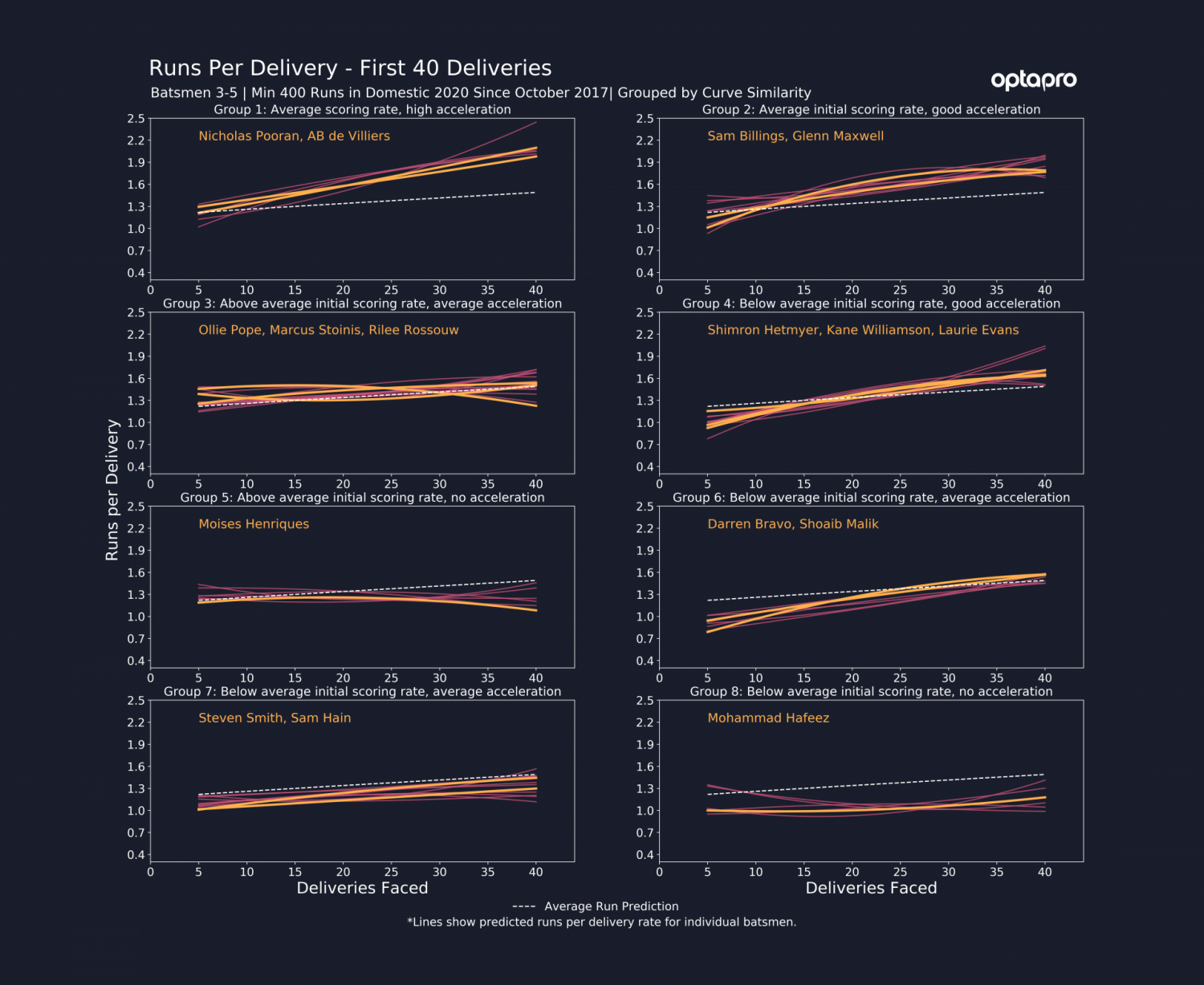
Identifying finishers
Every successful limited overs team requires a finisher who can accelerate at the death and successfully chase down totals.
Andre Russell recorded 52 sixes in the 2019 IPL (3.5 per innings) and unsurprisingly appears in the category of players who score quickly initially and accelerate at a high rate.
Russell enters the draft with a reserve of £100,000, however he is not the only player to appear in the most aggressive category. He is joined by his international teammate Fabian Allen, who is one of a number of overseas players entering the draft with no reserve.
Another West Indian allrounder possessing a £100,000 reserve is Dwayne Bravo, however his recent performances suggest that he has been unable to maintain early momentum as his innings develops, which may be a key consideration for teams during the initial draft picks.
Amongst domestic players, Glamorgan captain Chris Cooke stands out as a player who can accelerate quickly late on, albeit in a team which has had limited recent success in T20 cricket. In contrast, Ross Whiteley has helped Worcestershire to successive Blast Finals Days and sits alongside the likes of Kieran Pollard and Carlos Braithwaite in a group of late order batters who can score quickly once set.
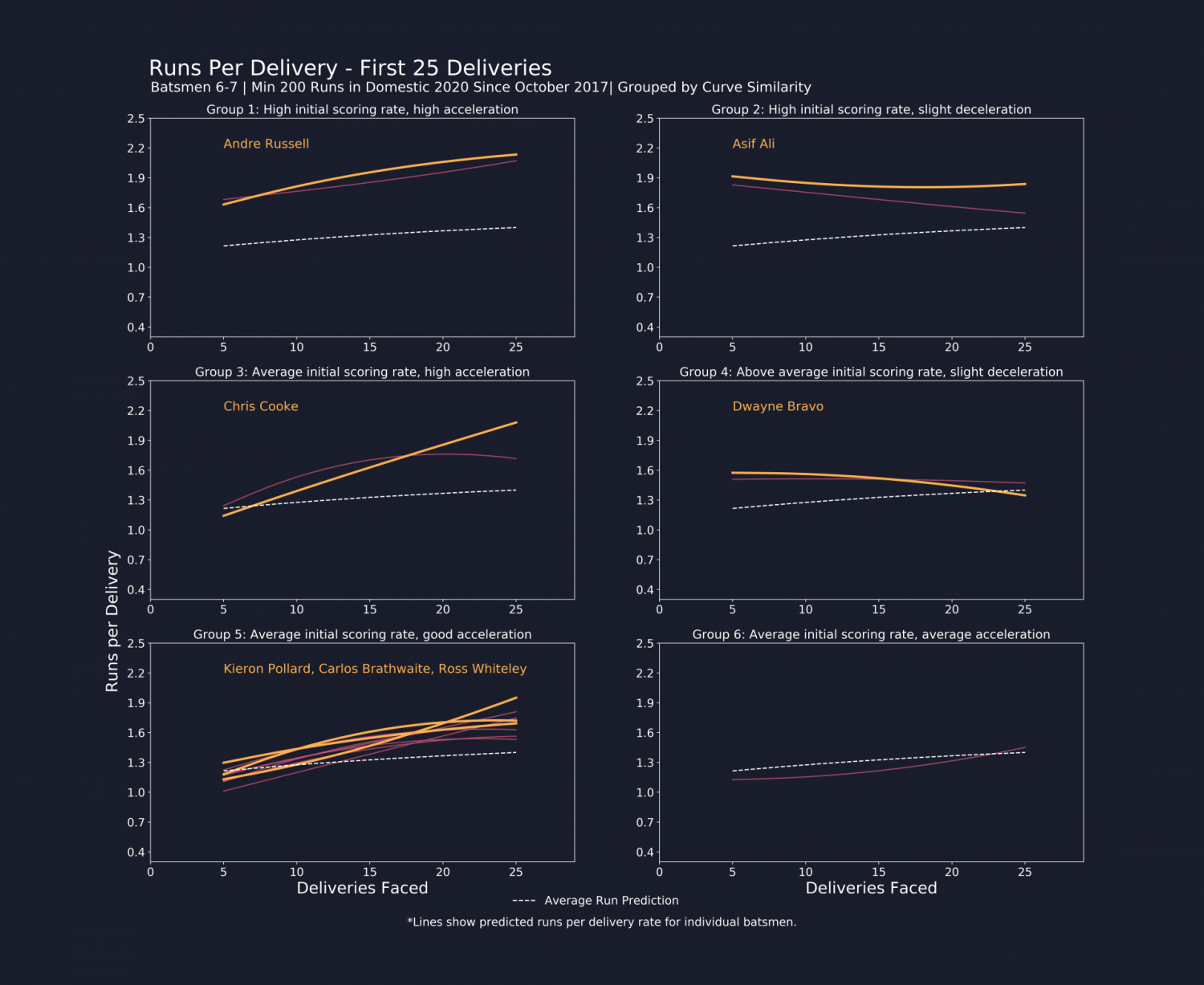
Supporting recruitment decision-making
Grouping batsmen based on their projected scoring rates is one way to support Hundred franchise coaches and analysts with the initial identification of players who can fulfil the specific batting roles they are looking for.
Once these have been established, further in-depth analysis into technical skills, shot selection and performance outputs against different types of bowling can help further narrow down the list of viable options.
This workflow can ensure that franchises go into the draft equipped not only with a list of first-choice targets, but also strong back-up selection options to maximise their chances of securing a strong, well-balanced group of batsmen for next year’s competition.
If you would like to know more about OptaPro’s advanced batting metrics or have any questions relating to what we have developed so far, please do get in touch with us at pro@optasports.com